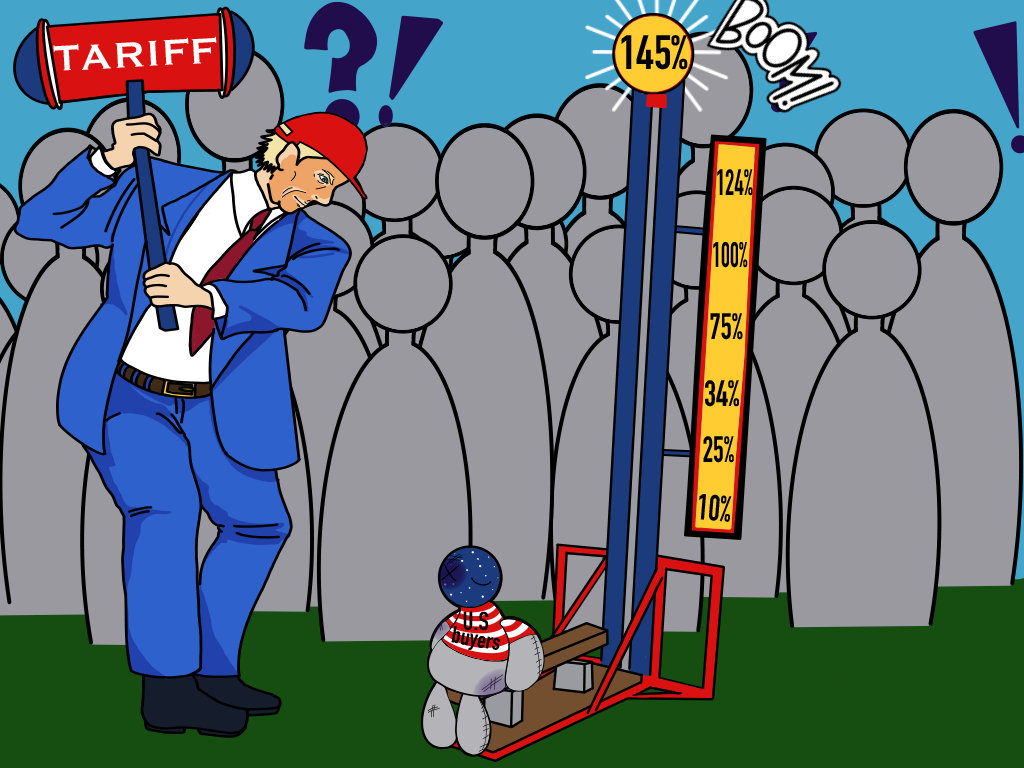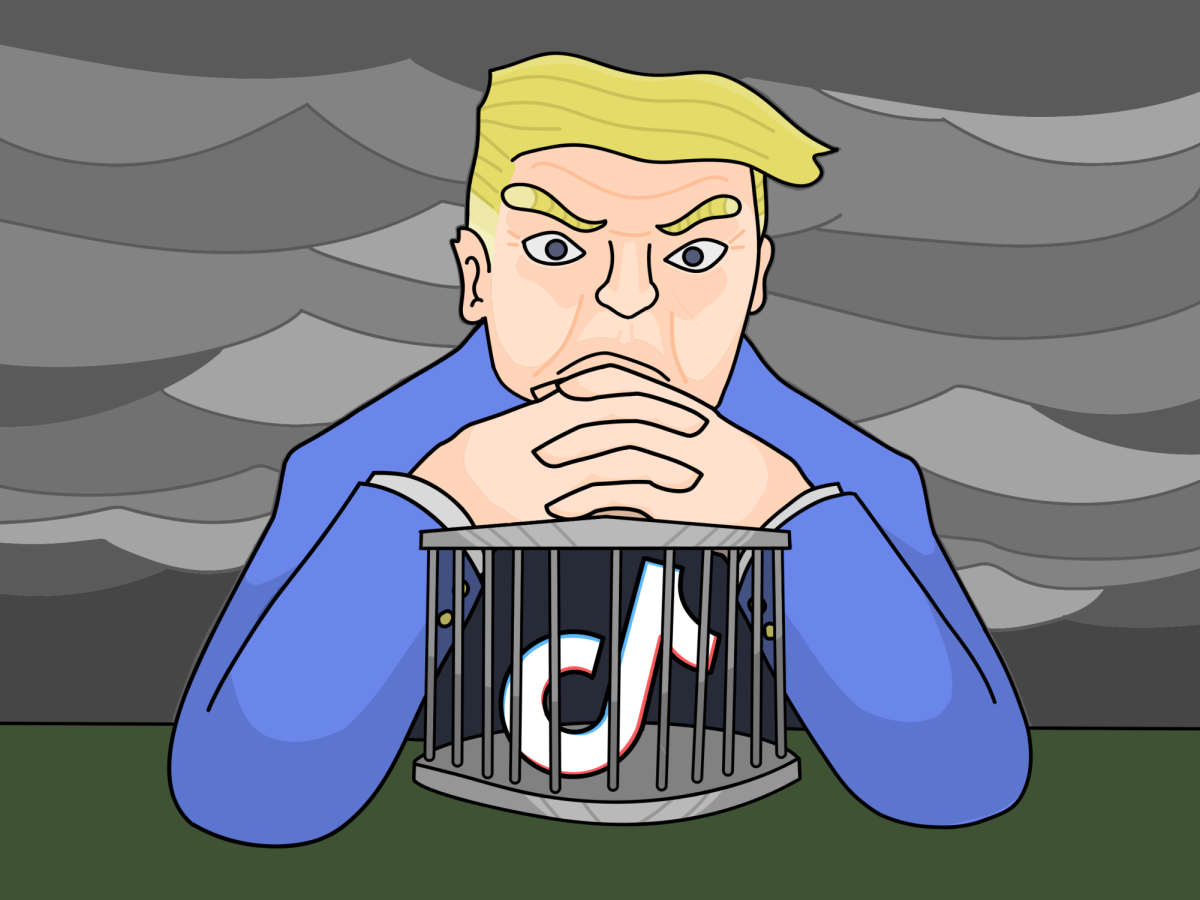“Flood the zone.” “Shock and awe.” “Blitz.”
These are all phrases that have been used to describe the speed and intensity through which Donald Trump has sought to remake the United States of America through the power of executive orders.
As of Feb. 11, Trump has signed 93 executive orders since his inauguration, aimed at advancing his policy agenda. These orders span a wide range of policy areas — from immigration to public school — and many of them have already been challenged in court.
Because the Republicans have a razor-thin majority in the U.S. House of Representatives and a 53-47 majority in the Senate, Trump has sought to push the limits of presidential power by issuing executive orders, which some critics have said are written in ways that make them unconstitutional.
How are executive orders different than laws?
Executive orders do not carry the same legal weight as a law. Instead, an executive order is a written directive, signed by the president, that orders the government to take specific actions to ensure “the laws be faithfully executed.” According to the American Civil Liberties Union, they could tell a federal agency like the Department of Homeland Security how to enforce immigration laws or declare new policy priorities. However, executive orders cannot override existing federal laws and statutes, which are passed by Congress and signed by the president. Additionally, the Constitution gives Congress control over things like taxing and spending, which also appears to be in Trump’s list of targets to take control over. “It’s up for debate, because executive orders have always been a little bit iffy on that line, on if they actually are constitutional, but that’s why we have, checks and balances. So my main concern isn’t whether or not they’re constantly, whether they’re constitutional, it’s whether the federal courts are actually going to hold him to that standard,” social studies teacher Adam Gorrell said.
What Trump can and cannot do through Executive Order?
With an executive order, President Trump can order the federal government to take steps that are within the scope of the constitutional authority of the executive branch, and do not violate any federal law, according to the ACLU. What Trump cannot do through an executive order is write a new statute. However, a president could use such an order to tell the Department of Justice how to prioritize the prosecution of certain offenses such as drug cases. Because the founders of the Constitution sought to create a set of checks and balances so no one branch of the government is more powerful than the other, the courts have typically blocked presidents from using executive orders to sidestep those checks and balances.While campaigning and in the first days of his second term as President, Trump has vowed to enact a sweeping agenda and reshape the federal government, naming priorities such as mass deportations, trade wars with other countries, and reprioritizing national security concerns.
According to an analysis of Trump’s executive orders so far, he has signed orders in the following categories:
Various organizations like the American Civil Liberties Union, Public Citizen, and various federal employees unions have already sued the Trump administration to stop some of the orders. Some law firms and publications have made web pages tracking the status of these lawsuits to help people know whether the executive orders are in effect or not.“So it’s really going to be up to the Circuit Court of Appeals, and we’re going to have to rely on federal judges that were put in place by the various administrations. So that’s the main thing that worries me, is that system going to hold,” Gorrell said. For example, so far two federal judges have blocked Trump’s executive order aimed at ending birthright citizen- ship for the children of parents who are in the U.S. illegally. For now the order is on hold. U.S. District Judge John C. Coughenour in Seattle issued a 14-day temporary restrain- ing order blocking its implementation, calling it “blatantly unconstitutional.” And then a day later, U.S. District Judge Deborah Boardman in Maryland issued an injunction keep- ing Trump’s order on hold long-term. Trump is simply trying to amend the 14th Amendment which grants citizenship to those born in the U.S. and subject to its jurisdiction — for political reasons, Coughe- nour said after a hearing of the case, according to an article by the Associated Press.“The rule of law is, according to him, something to navigate around or something ignored, whether that be for political or personal gain,” he said. “In this courtroom and under my watch the rule of law is a bright beacon, which I intend to follow.”Since then, the U.S. Justice Department appealed his order to the 9th U.S. Circuit Court of Appeals and will likely appeal the ruling in Maryland to the 4th Circuit.
Other Executive Actions to Remake the Federal Government
In addition to using Executive Orders, Trump has used other actions to exert control over the government through his cabinet members and so- called “Special Gov- ernment Employ- ees” like Elon Musk, who is heading up
a new office called the Department
of Government Efficiency, created by Trump.
Musk, who is the
world’s richest
man and became a supporter of Trump
during the campaign,
has an office on the
White House campus.
Since Trump took office, Musk has worked to reshape
the federal government even though the limits of its au- thority have never been fully outlined.
While DOGE has little institutional authority on paper,
in practice it has charged ahead, using what critics have called slash-and-burn tactics to gut the federal bureau- cracy and fire federal workers. This includes DOGE staff gaining access to sensitive government payment databas- es, which are being combed through looking for anything that does not align with Trump administration directives.
‘Traumatically affected’
The Trump administration has also used the U.S. Office
of Personnel Management to shrink the federal work- force when it sent two million federal employees an email containing a deferred resignation offer, encouraging them to leave their jobs. Lawsuits and court rulings have put this effort on hold for now.
After the U.S. Senate confirmed Russell Vought to be the director of the Office of Management and Budget, federal employees are worried about what else the Trump adminis- tration has in store for them. Vought, who is a co-author of the Project 2025 plan that became controversial during the 2024 Presidential campaign, has made public speeches in which he has said he wants “bureaucrats to be traumatical- ly affected,” he said in a video of the speech.
“When they wake up in the morning, we want them to not want to go to work, because they are increasingly viewed
as the villains. We want their funding to
be shut down
The Eagle’s Eye Page 13 | Feb. 14, 2025
so that the EPA [Environmental Protection Agency] can’t do all of the rules against our energy industry, because they have no bandwidth financially to do so.”
Trump’s effort to shut down the U.S. Department of Education
One of area of particular concern for public schools
like Akins is whether Trump will follow through with his promises to close the U.S. Department of Education, which he promised to do during his campaign. The department has broad responsibility over three major areas: managing federal student loans, overseeing implementation and enforcement of the nation’s special education law, and administering Title 1, the main federal program aimed at improving outcomes for lower-income students.
Akins receives federal funding for special education and Title 1, worrying special education staff at Akins about what it could mean for students and staff.
“It makes me a little bit more afraid for job security, be- cause I specifically teach special education, and one of the executive orders that he’s putting in is to try to eliminate the Department of Education,” an Akins teacher said. “If Texas were to decide that that wasn’t important anymore, without the Department of Education making sure that they’re doing that, they could just decide to fire all the sped teachers and save money. You know, if they wanted to do that,”
While Trump’s executive order is expected to outline sig- nificant cuts to the Education Department, the department cannot be closed through executive action alone because it was created by an act of Congress in 1979, meaning that it can only be eliminated by an act of Congress.
For context the orders mentioned/referenced are sum- marized and listed below.
PROTECTING THE UNITED STATES FROM FOREIGN TERRORISTS AND OTHER NATIONAL SECURITY
AND PUBLIC SAFETY THREATS
This order is to protect citizens from im- migrants who intend to commit terrorists
attacks, threaten national security, spread hateful ideology, or otherwise exploit the
immigration laws for malevolent purposes. This act states that the United States
must be vigilant during the visa-issu- ance process to ensure that immigrants
approved for admission into the US and do not intend to harm Americans
or national interests. They must be identified before their admission to the
United States. It says that admitted immigrants and immigrants already present in the United States should not bear hostile attitudes towards its
citizens, culture, government, insti- tutions, or founding principals, and do
not advocate for or support foreign terrorists and other threats to national
security.
PROTECTING THE MEANING AND VALUE OF AMERICAN CITIZENSHIP
The privilege of United States citizenship is a profound gift. The Fourteenth amend-
ment states: “All persons born or naturalized in the United States, and subject to the jurisdiction
thereof, are citizens of the United States and of the
State wherein they reside.” That provision rightly repudiated Supreme Court of the United States’s shameful decision
in Dred Scott v. Sandford, 60 U.S. (19 How.) 393 (1857). This misinterpreted the Constitution as permanently excluding people of African descent from eligibility for citizenship solely based on race.
This said the Fourteenth Amendment has never been interpreted to extend citizenship universally to everyone born within the United States. The Amendment always excluded birthright citizenship to people who were born in the United States but not “subject to the jurisdiction there- of”. Consistent with this understanding, the Congress has further specified through legislation that “a person born in the United States, and subject to the jurisdiction thereof” is a national and citizen of the United States at birth.
Among the categories of individuals born in the United States and not subject to the jurisdiction thereof, the privilege of citizenship does not automatically extend to people born in the United States: (1) When that person’s mother was unlawfully present in the United States and the father was not a United States citizen or lawful permanent resident at the time of said person’s birth, or (2) when that person’s mother’s presence in the United States at the time of said person’s birth was lawful but temporary such as visa’s including student,work, or tourist visas and the father wasn’t a United states citizen or lawful permanent resident at the time of said person’s birth.
PROTECTS CIVIL RIGHTS AND MERIT-BASED OPPORTUNITY BY ENDING ILLEGAL DEI
Protects the civil rights of all Americans and expands individual opportunity by terminating DEI preferencing in federal contracting and directing federal agencies to re- lentlessly combat private sector discrimination. It enforces long-standing federal statutes and faithfully advances the Constitution’s promise of colorblind equality before the law. It terminates “diversity, equity, and inclusion” (DEI) discrim- ination in the federal workforce, and in federal contracting and spending.
Federal hiring, promotions, and performance reviews
will reward individual initiative, skills, performance, and hard work and not, under any circumstances, DEI-related factors, goals, policies, mandates, or requirements. The order requires OMB to streamline the federal contracting process to enhance speed and efficiency, reduce costs, and require Federal contractors and subcontractors to comply with our civil rights laws. It revokes Executive Order 11246 contracting criteria mandating affirmative action. It bars the Office of Federal Contract Compliance Programs from pushing contractors to balance their workforce based on race, sex, gender identity, sexual preference, or religion. It requires simple and unmistakable affirmation that con- tractors will not engage in illegal discrimination, including illegal DEI. It directs all departments and agencies to take strong action to end private sector DEI discrimination, including civil compliance investigations. It mandates the Attorney General and the Secretary of Education issue joint guidance regarding the measures and practices required to comply with the Supreme Court’s decision in Students for Fair Admissions v. Harvard. Individual dignity, hard work, and excellence are fundamental to American greatness. This Executive Order reaffirms these values by ending
the Biden-Harris Administration’s anti-constitutional and deeply demeaning “equity” mandates, terminating DEI, and protecting civil rights.













